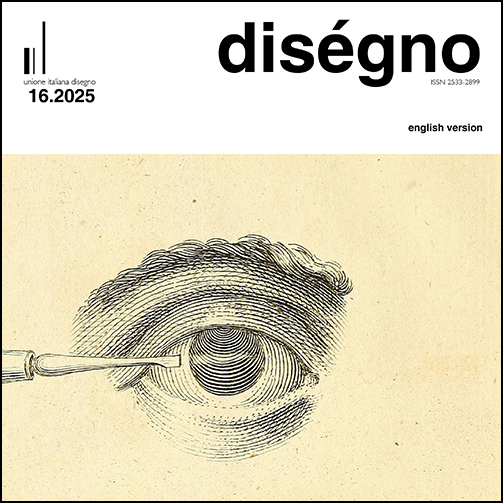Anatomy of a Prompt: a Semiotic System of Text-to-Image Gen AI
DOI:
https://doi.org/10.26375/disegno.16.2025.24Keywords:
drawing, semiotic system, Generative AI, prompt, visual languageAbstract
Text-to-image Generative AI (Gen AI) introduces a novel perspective on the notion of drawing as a language. This study employs Saussure’s Semiotic Theory to investigate how architectural and interior design prompts in DiffusionDB (part-000001) function as a semiotic system. The filtered dataset includes 246 architecture-related prompts (APs) and 276 interior design-related prompts (IDPs), validated through random sampling and visual inspection. Among the APs, 98% featured terms like ‘architecture’ and ‘design’ with ‘building’, ‘nature’, and ‘archdaily’ appearing in 71-72%. Other prevalent themes included ‘city’ (59%), ‘art’, and ‘digital’ (48%), reflecting a conceptual emphasis on physical structures integrated with environmental and stylistic elements. In contrast, IDPs showed a 100% occurrence of ‘style’, followed by ‘light’ (74%) and ‘concept’ (63%), suggesting a focus on stylistic expression and ambient qualities. The findings indicate that APs center around ‘building’ as the core term, while IDPs are anchored by ‘style’.
Notably, ArchDaily and Artstation emerged as linguistic and visual archives, informing the prompt structures. This semiotic analysis reveals that Gen AI users consciously employ architectural vocabulary and artistic techniques, crafting prompts as intentional design compositions that bridge language, imagery, and social meanings in architecture and interior design.
References
Álvarez, D. (2024). Representation and Design in Historic Gardens. In diségno, No. 15, pp. 31-43. https://doi.org/10.26375/disegno.15.2024.4.
Amore, M. P. (2023). ‘Abstract Machine’. Diagrams in Project Narrative. In diségno, No. 13, 43-56. https://doi.org/10.26375/disegno.13.2023.7.
Boudier, J., Sukhov, A., Netz, J., Le Masson, P., Weil, B. (2023). Idea evaluation as a design process: understanding how experts develop ideas and manage fixations. In Design Science, Vol. No 9, e9. https://doi.org/10.1017/dsj.2023.7.
Carson, T., Pearson, M., Johnston, I., Mangat, J., Tupper, J., & Warburton, T. (2005). Semiotic approaches to image-based research. In B. Somekh, C. Lewin (Eds.). Research methods in the social sciences, pp. 169-171. London: SAGE Publications. <https://research.ebsco.com/linkprocessor/plink?id=-2de03f07-01a3-3d04-8d96-31baf5022494> (accessed 6 April 2025).
Chandler, D. (2007). Semiotics: The basics (2nd ed.). London: Routledge.
Creswell, J. W., Clark, V. L. P. (2017). Designing and conducting mixed methods research (3rd ed.). London: SAGE Publications.
Culkin, J. M. (1967). A schoolman’s guide to Marshall McLuhan. In The Saturday Review, March 18, 1967, pp. 51-53; 70-72: <https://www.unz.com/print/SaturdayRev-1967mar18-00051> (accessed 6 April 2025).
Dade-Robertson, M. (2011). The architecture of information: architecture, interaction design and the patterning of digital information. London: Routledge. https://doi.org/10.4324/9780203828380.
Dilaveroglu, B. (2024). The architecture of visual narrative: Can text-to-image algorithms enhance the power of stylistic narrative for architecture. In International Journal of Architectural Computing, 22(3), pp. 432-457. https://doi.org/10.1177/14780771241234449.
Florio, R. (2023). The Acts of Drawing: ‘procedere’ and ‘cedere-pro’. In diségno, No. 13, pp. 21-30. https://doi.org/10.26375/disegno.13.2023.5.
Foster, J. (2020). Python for beginners: Learn the fundamentals of computer programming. Elluminet Press. <https://research.ebsco.com/linkprocessor/plink?id=80c0bbbe-da8e-3f23-a77c-030f4135bd03> (accessed 6 April 2025).
Häusler, C., Bansal, A., Meng, Z., Peysakhovich, A., Kim, B. (2023). Stable bias: Evaluating societal representations in diffusion models. In Proceedings of the 37th Conference on Neural Information Processing Systems (NeurIPS 2023): <https://arxiv.org/abs/2305.15391> (accessed 6 April 2025).
Kazimir, A. (2023). Kazimir-ai/text-to-image-prompts. https://huggingface.co/datasets/Kazimir-ai/text-to-image-prompts (accessed 6 April 2025).
Lim, J.-S., Jung, E.-C. (2018, June 25-28). A study on the roles of designers co-evolving with tools. In C. Storni, K. Leahy, M. McMahon, P. Lloyd, E. Bohemia (Eds.). Design as a catalyst for change - DRS International Conference 2018, 25-28 June, Limerick, Ireland. https://doi.org/10.21606/drs.2018.533.
Mancini, M. F., Menconero, S. (2023). AI-aided Design? Text-to-image Processes for Architectural Design. In diségno, No. 13, pp. 57-70. https://doi.org/10.26375/disegno.13.2023.8.
Massironi, M. (2002). The psychology of graphic images: Seeing, drawing, communicating (N. Bruno, Trans.). L. Erlbaum. https://research.ebsco.com/linkprocessor/plink?id=7979c400-6211-3875-89ee-71769e9cd842
Melis, A. (2023). Architecture through Drawing. In diségno, No. 13, pp. 33-42. https://doi.org/10.26375/disegno.13.2023.6.
Microsoft. (2023). Visual Studio Code. https://code.visualstudio.com/ (accessed 6 April 2025).
Papidou, T. (2014). Double writing in architectural design: A phenomenological-semiotic approach. In E. Zantides (Ed.), Semiotics and visual communication: Concepts and practices, pp. 23-32. Cambridge: Cambridge Scholars Publishing.
Palestini, C. (2022). Research and Archives of Architecture. The Roles and Disseminations of Drawing. In diségno, No. 10, pp. 7-17. https://doi.org/10.26375/disegno.10.2022.2.
Ranzo, P. (2022). From Digital to Postdigital: the Dialogical Relationship between Drawing and Design. In diségno, No. 11, pp. 37-42. https://doi.org/10.26375/disegno.11.2022.6.
Rengel, R. J. (2023). The interior plan: Concepts and exercises (3rd ed.). London: Bloomsbury Publishing: <https://www.fairchildbooksinterior-design.com/encyclopedia?docid=b-9781501369681> (accessed 6 April 2025).
Saussure, F. de. (2011). Course in general linguistics (W. Baskin, Trans.). NewYork: Columbia University Press. <https://research.ebsco.com/linkprocessor/plink?id=09ccffd9-4b10-304b-a1cb-38dfb8304e60> (accessed 6 April 2025).
Soddu, C. (2002). New Naturality: A Generative Approach to Art and Design. In Leonardo, No. 35(3), pp. 291-294. https://doi.org/10.1162/002409402760105299.
Stawarska, B. (2015). Saussure’s philosophy of language as phenomenology: Undoing the doctrine of the course in general linguistics. Oxford: Oxford University Press. https://doi.org/10.1093/acprof:oso/9780190213022.001.0001.
Tørresen, J. (2021). Undertaking Research with Humans within Artificial Intelligence and Robotics: Multimodal Elderly Care Systems. In Technology|Architecture + Design, No. 5(2), pp. 141-145. https://doi.org/10.1080/24751448.2021.1967052.
Trimarchi, M. (2022). The Uselessness of Drawing. In diségno, No. 11, pp. 23-34. https://doi.org/10.26375/disegno.11.2022.5.
Turley, S. (2023). Stable Diffusion 100k Custom Prompts and Images. https://www.kaggle.com/datasets/rturley/stable-diffusion-100k-custom-prompts-and-images (accessed 6 April 2025).
Wang, Z. J., Montoya, E., Munechika, D., Yang, H., Hoover, B., Chau, D. H. (2022). DiffusionDB: A large-scale prompt gallery dataset for text-to-image generative models. arXiv:2210.14896 [cs]. <https://arxiv.org/abs/2210.14896> (accessed 6 April 2025).
Downloads
Published
How to Cite
Issue
Section
License
Copyright (c) 2025 diségno

This work is licensed under a Creative Commons Attribution 4.0 International License.






